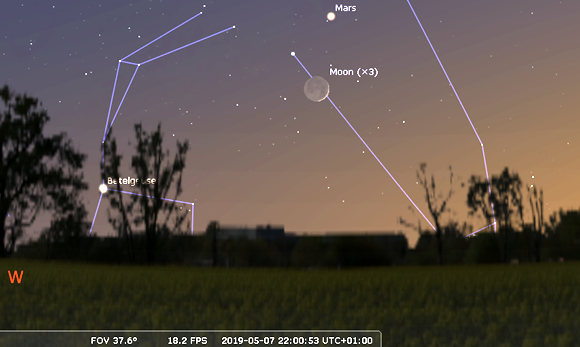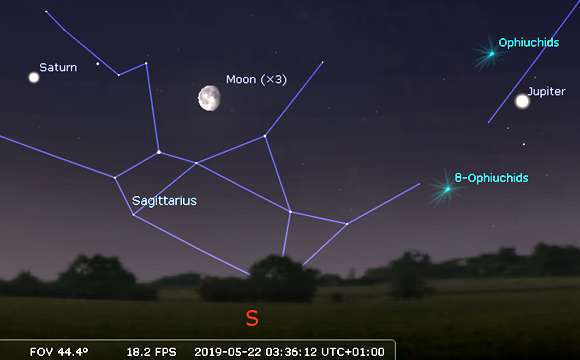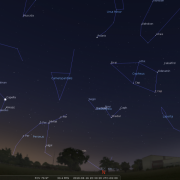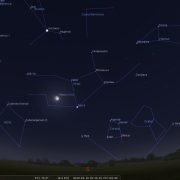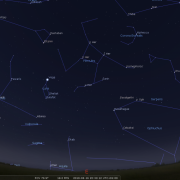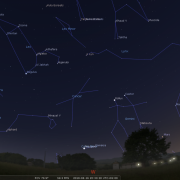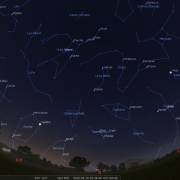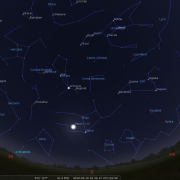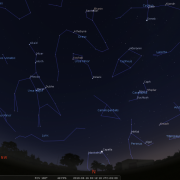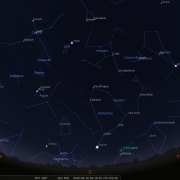In this month's Sky Notes:
Planetary Skylights
Evening Planets
 Mars remains the solitary naked eye planet visible in the evening sky until near the month end, but is gradually being overwhelmed by the lighter evenings. As dusk falls look for it low in the WNW at the start of the month between the ‘horn tip’ stars; zeta and beta tauri, in Taurus. The red planet then glides up into Gemini, clipping the northern edge of the open cluster M35, although that this whole area is slipping down to the horizon. The moon lies close by on the 7th.
Mars remains the solitary naked eye planet visible in the evening sky until near the month end, but is gradually being overwhelmed by the lighter evenings. As dusk falls look for it low in the WNW at the start of the month between the ‘horn tip’ stars; zeta and beta tauri, in Taurus. The red planet then glides up into Gemini, clipping the northern edge of the open cluster M35, although that this whole area is slipping down to the horizon. The moon lies close by on the 7th.
A crescent Moon accompanies Mars at the beginning of May; and a waning moon
is accompanied by Saturn and Jupiter towards the end of May. Click for full-sized images.
 At the very end of the month Mercury makes a so-so evening appearance, joining Mars in the early June sky. Look for a reasonably ‘bright star’ very low to the NW horizon approximately 45 minutes after sunset.
At the very end of the month Mercury makes a so-so evening appearance, joining Mars in the early June sky. Look for a reasonably ‘bright star’ very low to the NW horizon approximately 45 minutes after sunset.
 The early morning sky is home to the solar systems two largest planets; Jupiter and Saturn. Conspicuous Jupiter begins the month rising as a morning object, visible above the SE horizon by 1am. It ends the month rising as a late evening object, visible as twilight deepens (around 22:30h). Jupiter resides to the right of the ‘Teapot’ asterism in Sagittarius and is moving in retrograde motion against the backdrop of stars. At magnitude -2.55 it continues to brighten as it heads towards opposition on June 10th.
The early morning sky is home to the solar systems two largest planets; Jupiter and Saturn. Conspicuous Jupiter begins the month rising as a morning object, visible above the SE horizon by 1am. It ends the month rising as a late evening object, visible as twilight deepens (around 22:30h). Jupiter resides to the right of the ‘Teapot’ asterism in Sagittarius and is moving in retrograde motion against the backdrop of stars. At magnitude -2.55 it continues to brighten as it heads towards opposition on June 10th.
Observations will be a little tricky for a while with regard to timings, this aside from the fact Jupiter (and Saturn) are both low on the ecliptic and hence not very high above the horizon. The choice is therefore to rise very early or wait until the month’s end and stay up late, thereafter Jupiter will become increasingly an evening object, albeit in the light skies of summer.
If you do make the effort, there is always something of interest to view in the eyepiece, especially as the disc is a whopping 46 arc seconds in size. So whether it’s the cloud band features, or the dance of the Galilean moons, Jupiter is a fine object to follow. Our moon pays Jupiter a visit on the 21st.
Jupiter Galilean moon shadow transits, dates of interest as follows:
7th, 13th, 14th, 20th, 28/29th and 31st . Events between 23:35h and 03:30h.
The great red spot transits on the disk on the following dates:
1st, 5/6th, 10/11th, 15/16th, 17/18th, 21-25th, 27/28/29/30th all between 01.15h and 03:45h.
 Saturn trails Jupiter into the sky by just a couple of hours and although not as conspicuous is nevertheless quite prominent to the naked eye. It resides to the left of the ‘teapot’ asterism - pretty low to the horizon, so observations are going to be somewhat compromised due to our atmosphere. Turn a telescope towards its soft pearly hue and you should see the distinctive rings, which are currently orientated very favourably. Have patience and wait for those steadier ‘seeing’ moments. The moon lies nearby on the 23rd.
Saturn trails Jupiter into the sky by just a couple of hours and although not as conspicuous is nevertheless quite prominent to the naked eye. It resides to the left of the ‘teapot’ asterism - pretty low to the horizon, so observations are going to be somewhat compromised due to our atmosphere. Turn a telescope towards its soft pearly hue and you should see the distinctive rings, which are currently orientated very favourably. Have patience and wait for those steadier ‘seeing’ moments. The moon lies nearby on the 23rd.
 Venus is technically visible very low to the east horizon less than 30 minutes before sunrise.
Venus is technically visible very low to the east horizon less than 30 minutes before sunrise.
Ceres at Opposition
Following the opposition of Pallas last month, the largest dwarf planet, Ceres, reaches opposition at the end of May. You will need to observe around midnight to spot it, as it lies in the southern part of Ophiuchus, bordering Scorpius.
At magnitude +7.0 Ceres should be readily visible in 10x50 binoculars, but a small telescope may be the best instrument to track it down. Approaching 600 miles in diameter, Ceres is spherical in shape, accounting for perhaps one third of the mass of the asteroid belt between Mars and Jupiter.
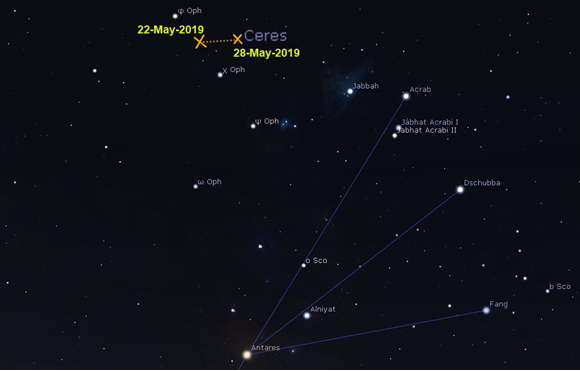
Finder Chart for Ceres, towards the end of May 2019.
In 2015 Ceres was visited by the NASA DAWN spacecraft, which sent pictures back of this rock and ice world. The observing window is best before the 10th or after the 22nd around 1am local time. You will require a flat south east aspect as Ceres will be 15-20 degrees above the horizon by the end of May. Ceres is roughly heading to east to west slightly above and left of beta Scorpii. See chart for details. Good hunting.
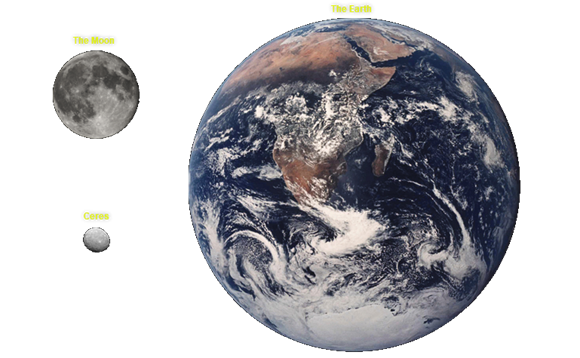
Size Comparison of Ceres next to Earth and the Moon. Image from Wikipedia Commons.
Meteors

If you are a very early riser, look out for some shooting stars around May 5th-7th, when the eta Aquarid meteor shower reaches a peak. The actual peak falls on the 6th. This is one of two meteor showers associated with debris particles deposited over time by comet Halley, the other shower being the Orionids seen in late October.
Eta Aquarids have a ZHR (zenith hourly rate) approaching 30, but with Aquarius only just rising in the SE shortly before dawn, observations from the UK are always somewhat restricted. The radiant of the shower lies close to eta Aquarius, one of the stars making up the "water jar" in the otherwise faint constellation of Aquarius. View around 4am to the south and east.
May 2019 Sky Charts
|
Looking North
Mid-May - 22:30h |
Looking South |
|
Looking East
Mid-May - 22:30h |
Looking West
Mid-May - 22:30h |
|
Northern Aspect
Mid-May - 22:30h |
Southern Aspect
Mid-May - 22:30h |
| Looking North (Early) Mid-May - 03:15h |
Looking South (Early) Mid-May - 03:15h |
Additional Image Credits:
- Planets and Comets where not otherwise mentioned: NASA
- Sky Charts: Stellarium Software
- Log in to post comments

